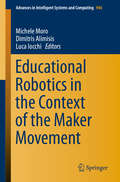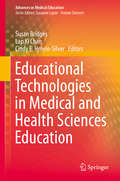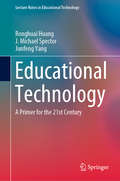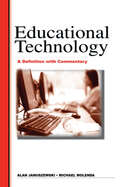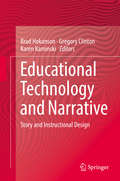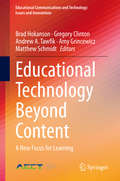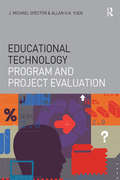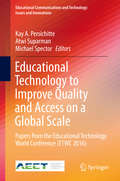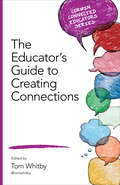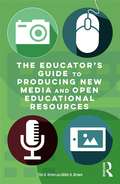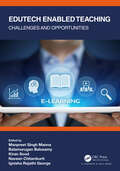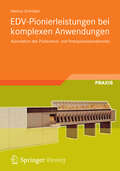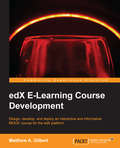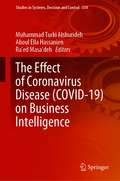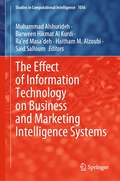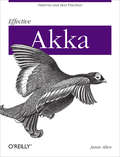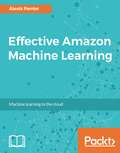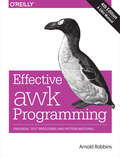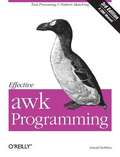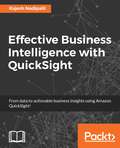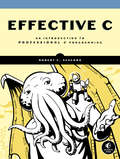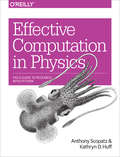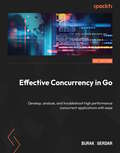- Table View
- List View
Educational Robotics in the Context of the Maker Movement (Advances in Intelligent Systems and Computing #946)
by Dimitris Alimisis Michele Moro Luca IocchiThis book gathers papers presented at the International Conference “Educational Robotics in the Maker Era – EDUROBOTICS 2018”, held in Rome, Italy, on October 11, 2018. The respective chapters explore the connection between the Maker Movement on the one hand, and Educational Robotics, which mainly revolves around the constructivist and constructionist pedagogy, on the other. They cover a broad range of topics relevant for teacher education and for designing activities for children and youth, with an emphasis on using modern low-cost technologies (including block-based programming environments, Do-It-Yourself electronics, 3D printed artifacts, intelligent distributed systems, IoT technology and gamification) in formal and informal education settings.The twenty contributions collected here will introduce researchers and practitioners to the latest advances in educational robotics, with a focus on science, technology, engineering, arts and mathematics (STEAM) education. Teachers and educators at all levels will find valuable insights and inspirations into how educational robotics can promote technological interest and 21st century skills – e.g. creativity, critical thinking, teamwork, and problem-solving – with a special emphasis on new making technologies.
Educational Technologies in Medical and Health Sciences Education
by Susan Bridges Lap Ki Chan Cindy E. Hmelo-SilverThis evidence-packed guide explores the growing importance of new technologies and situated learning in the vanguard of medical and health sciences education, backed by real-world clinical applications. Its dual emphasis on problem-based learning (PBL) and applied learning is reflected in the range of author perspectives, from understanding how technologies engage learners to implications for program design. Innovations covered range from wider and more targeted use of mobile devices and electronic medical records to video cases and virtual patients, in clinical contexts from family practice to specialized surgery. At the same time, chapters detail both the necessary hardware for putting these systems into place and the software needed to make them accessible to learners. Among the featured topics: Technology and group processes in PBL: An ethnographic study. What is real? Using problem-based learning in virtual worlds. Are Wikipedia articles reliable learning resources in PBL curricula? Utilizing mobile electronic health records in clinical education. Measuring emotions in medicine: methodological and technological advances within authentic medical learning environments. The deteriorating patient smartphone app: towards serious game design. Medical/health sciences educators and researchers in educational technology will look to Educational Technologies in Medical and Health Sciences Education to pinpoint current and future trends in an ever-important field.
Educational Technology: A Primer for the 21st Century (Lecture Notes in Educational Technology)
by Ronghuai Huang J. Michael Spector Junfeng YangThe aim of this book is to prepare students with knowledge and skills to understand the organizational needs and requirements of educational technology. Students should be able to use and manage both existing and emerging technologies effectively and be able to apply associated pedagogies to suit the environment, but also evaluate and manage technological advances of future and the requisite pedagogical shifts to achieve efficiency and effectiveness. The demand of educational technology has been rising steadily, primarily due to the fact that e-learning is a huge and significantly expanding world-wide industry. Commercial e-learning companies, training departments in large companies and organizations, computer software companies and educational institutions the world over employ large numbers of educational technology specialists. There is a strong demand for technologists who understand educational theories and for instructional designers and teachers who understand technologies. This book is targeted towards those who are looking for career in educational technology, instructional design, or media and information systems, or may want to continue their studies in graduate programs in learning and instructional technology, and those who are interested in becoming teacher in K-12 setting but need background in educational technology. This book will also act as a valuable resource in teacher education programs where primary focus on mainstream education and requires an authentic resource in instructional design and educational technology. Keeping in mind the varied needs of the organizations, employees and potential students, this book adopts a competency approach to learning and assessment. The themes and topics take a multi-disciplinary approach, and are aimed at preparing students for competent and innovative educational technology professionals.
Educational Technology: A Definition with Commentary
by Michael Molenda Alan JanuszewskiSponsored by the Association for Educational Communications and Technology (AECT), this book presents a definition of the field of study and practice known as educational technology or instructional technology. It reflects the collaborative efforts of all members of the AECT Definition and Terminology Committee. The volume begins with the statement of the definition itself (chapter 1), followed by commentary chapters on each of the key terms and concepts contained in the definition (chapters 2-9). Chapter 10 provides historical context for the current definition by reviewing salient elements of prior AECT definitions. Chapter 11 discusses ethical considerations and chapter 12 concludes by discussing ramifications of the current definition for academic programs in educational technology. This book is appropriate for anyone working in the field of educational technology: students, instructors, researchers and in-service providers.
Educational Technology and Narrative: Story And Instructional Design
by Karen Kaminski Brad Hokanson Gregory ClintonThis volume is the result of a 2016 research symposium sponsored by the Association for Educational Communications and Technology (AECT) focused on the growing theoretical areas of integrating story and narrative into educational design. Narrative, or storytelling, is often used as a means for understanding, conveying, and remembering the events of our lives. Our lives become a series of stories as we use narrative to structure our thinking; stories that teach, train, socialize, and create value. The contributions in this volume examine stories and narrative in instructional design and offer a diverse exploration of instructional design and learning environments. Among the topics discussed: The narrative imperative: creating a story telling culture in the classroom. Narrative qualities of design argumentation. Scenario-based workplace training as storytelling. Designing for adult learners' metacognitive development & narrative identity. Using activity theory in designing science inquiry games . Changing the narrative of school: toward a neurocognitive redefinition of learning. Educational Technology and Narrative is an invaluable resource offering application-ready ideas to students of instructional design, instructional design practitioners, and teachers seeking to utilize theories of story and narrative to the ways that they convey and express ideas of instructional design and educational technology.
Educational Technology Beyond Content: A New Focus for Learning (Educational Communications and Technology: Issues and Innovations)
by Brad Hokanson Gregory Clinton Andrew A. Tawfik Amy Grincewicz Matthew SchmidtThis book is the outcome of a research symposium sponsored by the Association for Educational Communications and Technology [AECT]. Consisting of twenty-four chapters, including an introduction and conclusion, it argues that informational content should not be the main element of education, and that to provide more for learners, it is necessary to go beyond content and address other skills and capabilities. It also discusses the false premise that learning is complete when the information is known, not when learners seek more: their own directions, answers, and ideas. The authors assert that the ability to synthesize, solve problems and generate ideas is not based on specific content, although education often focuses solely on teaching content. Further, they state that content can be separated from the learning process and that instructional design and educational technology must be about the skills, habits, and beliefs to be learned.
Educational Technology Program and Project Evaluation (Interdisciplinary Approaches to Educational Technology)
by J. Michael Spector Allan H.K. YuenEducational Technology Program and Project Evaluation is a unique, comprehensive guide to the formative and summative evaluation of programs, projects, products, practices and policies involving educational technology. Written for both beginning and experienced evaluators, the book utilizes an integrative, systems-based approach; its practical emphasis on logic models and theories of change will help readers navigate their own evaluation processes to improve interventions and conduct meaningful educational research. Key features include: evidence-based guidelines for constructing and conducting evaluations practical exercises to support the development of knowledge, skills, and program evaluation portfolios a variety of interdisciplinary case studies references and links to pertinent research and resources Using the TELL, ASK, SHOW, DO model first introduced in this series, Educational Technology Program and Project Evaluation provides comprehensive coverage of the concepts, goals, design, implementation, and critical questions imperative to successful technology-enhanced evaluation.
Educational Technology to Improve Quality and Access on a Global Scale
by Kay A. Persichitte Atwi Suparman Michael SpectorThis is an edited volume based on expanded versions of the best 30 papers presented at ETWC 2016 in Bali. Included are contributions from the keynote speakers of ETWC 2016: Robert Branch, Tian Belawati, Steve Harmon, Johannes Cronj#65533;, Marc Childress, Mike Spector, Chairul Tanjung, and Rudiantara. The work is organized into the following sections: (a) Effective Technology Integration in Teaching and Learning, (b) Quality Design, Development and Implementation, (c) Innovation and Creativity in Distance Education, and (d) Open Access, Courses and Resources.
The Educator's Guide to Creating Connections (Corwin Connected Educators Series)
by Tom WhitbyBlogging, social media, and PLN’s made easy! Collectively, we’re all smarter than we are individually. In this expert guide, EdTech leaders help you harness the power of connected collaboration using the Internet and social media. You’ll easily leverage Twitter, Facebook, LinkedIn and beyond for profound professional growth. Use real-world tips and tools to: Master and adapt to 21st Century teaching methodologies Build ongoing technology literacy for you and your students Connect and collaborate with education leaders across the globe Get connected. Get engaged. Use this inspiring, step-by-step manual to expand your personal and professional network today!
The Educator's Guide to Creating Connections (Corwin Connected Educators Series)
by Tom WhitbyBlogging, social media, and PLN’s made easy! Collectively, we’re all smarter than we are individually. In this expert guide, EdTech leaders help you harness the power of connected collaboration using the Internet and social media. You’ll easily leverage Twitter, Facebook, LinkedIn and beyond for profound professional growth. Use real-world tips and tools to: Master and adapt to 21st Century teaching methodologies Build ongoing technology literacy for you and your students Connect and collaborate with education leaders across the globe Get connected. Get engaged. Use this inspiring, step-by-step manual to expand your personal and professional network today!
The Educator's Guide to Producing New Media and Open Educational Resources
by Tim D. Green Abbie H. BrownDigital video, audio, and text have never been more popular, and educators need to know how to make new media work in all types of learning environments. The Educator’s Guide to Producing New Media and Open Educational Resources provides practical advice on how to produce and use open access resources to support student learning. This realistic "how-to" guide is written for education professionals in any discipline seeking to transform their instruction with technology.
Edutech Enabled Teaching: Challenges and Opportunities
by Manpreet Singh Manna Balamurugan Balusamy Kiran Sood Naveen Chilamkurti Ignisha Rajathi GeorgeThe primary goal of this book is to address the issues faced by teachers in the adoption of digital tools into their teaching and their students learning. This book also addresses the issues confronting educators in the integration of digital technologies into their teaching and their students’ learning. Such issues include a skepticism of the added value of technology to educational learning outcomes, the perception of the requirement to keep up with the fast pace of technological innovation, a lack of knowledge of affordable educational digital tools and a lack of understanding of pedagogical strategies to embrace digital technologies in their teaching. This book presents theoretical perspectives of learning and teaching today’s digital students with technology and proposes a pragmatic and sustainable framework for teachers’ professional learning to embed digital technologies into their repertoire of teaching strategies in a systematic, coherent and comfortable manner so that technology integration becomes an almost effortless pedagogy in their day-to-day teaching. Some of the objectives are given below: Shares valuable insights into the influence of technology on teaching and learning in higher education Provide deeper insights on higher education and sustainability interact Studies innovations from various perspectives Investigate how the educators and students apply the unique innovative and emotional dimensions in modern age of learning Provides a timely overview of changes in education reforms and policy research globally Evaluates the problematic relationship between globalization, the state, and education reforms.
EDV-Pionierleistungen bei komplexen Anwendungen
by Helmut SchröderDas Buch möchte die Leser in die Frühzeit der elektronischen Datenverarbeitung (EDV), nämlich die 50er, 60er und 70er Jahre des vorigen Jahrhunderts führen, an die sich heute noch sehr viele ehemalige EDV-Mitarbeiter "als Pioniere" gut und wohl auch gern erinnern werden. Wie kann man diese Zeitphase bezeichnen? Es war eine einmalige innovative Phase, durch gravierende technische Neuerungen wurde eine enorme Aufbruchstimmung ausgelöst. Für das Projekt "Automatisierung des Postscheck- und Postsparkassendienstes" werden die komplexen Entwicklungen dargestellt. Es war seinerzeit das EDV-Projekt mit dem größten Geschäftspotential eines einzelnen Kunden in Deutschland. Die elektronischen Datenverarbeitung (EDV) wurde zunächst geprägt von Großrechnern, die mathematische Aufgaben für Großforschungsinstitute und Universitäten als "Rechenknechte" lösten. Kommerzielle Anwendungn wurden durch zu langsame Ein-/Ausgabeeinheiten verhindert. Der Postminister Richard Stücklen entwickelte die Idee, eine automatisierte Lösung auch für seinen Postscheck- und Postsparkassendienst zu nutzen. Das Buch beschreibt die Erkundungsphase, das Umdenken von der Lochkarte zur Belegverarbeitung sowie die allgemeine Situation der Ausbildung und dem Bau von Rechenzentren. Aus der Entwicklungsphase bis ca. 1972 werden die Anwendungslösungen und Systemlösungen dargestellt und kommentiert. Pionierleistungen waren vor allem die zügige Automation des Postsparkassendienstes, die erste europaweite Kontenführung mit Belegverarbeitung im Postscheckdienst und der einzige Belegleser-Massentest mit Magnetschriften in Deutschland.
edX E-Learning Course Development
by Matthew A. GilbertIf you are an educator creating a course for edX or a corporate trainer using Open edX for large-scale learning and development initiatives, then edX E-Learning Course Development is the ideal book for you.
The Effect of Coronavirus Disease (Studies in Systems, Decision and Control #334)
by Muhammad Turki Alshurideh Aboul Ella Hassanien Ra’ed Masa’dehThis book includes recent research works on how business around the world affected by the time of COVID-19 pandemic. The impact of recent technological developments has had a tremendous impact on how we manage disasters. These developments have changed how countries and governments collect information. The COVID-19 pandemic has forced online service companies to maintain and build relationships with consumers when their world turns. Businesses are now facing tension between generating sales during a period of severe economic hardship and respect for threats to life and livelihoods that have changed consumer preferences.
The Effect of Information Technology on Business and Marketing Intelligence Systems (Studies in Computational Intelligence #1056)
by Muhammad Alshurideh Barween Hikmat Al Kurdi Ra’ed Masa’deh Haitham M. Alzoubi Said SalloumBusiness shapes have been changed these days. Change is the main dominant fact that change the way of business operations running. Topics such as innovation, entrepreneurship, leadership, blockchain, mobile business, social media, e-learning, machine learning, and artificial intelligence become essential to be considered by each institution within the technology era. This book tries to give additional views on how technologies influence business and marketing operations for insuring successful institutions survival.The world needs to develop management and intelligent business scenario plans that suite a variety of crisis appears these days. Also, business and marketing intelligence should meet government priorities in individual countries and minimise the risk of business disruptions. Business intelligence - the strategies and technology companies that use it to collect, interpret, and benefit from data - play a key role in informing company strategies, functions, and efficiency. However, being essential to the success, many companies are not taking advantage of tools that can improve their business intelligence efforts. Information technology become a core stone in business. For example, the combination of machine learning and business intelligence can have a far-reaching impact on the insights the company gets from its available data to improve productivity, quality, customer service and more. This book is important because it introduces a large number of chapters that discussed the implications of different Information technology applications in business. This book contains a set of volumes which are: 1- Social Marketing and Social Media Applications, 2- Social Marketing and Social Media Applications, 3- Business and Data Analytics, 4- Corporate governance and performance, 5- Innovation, Entrepreneurship and leadership, 6- Knowledge management, 7- Machine learning, IOT, BIG DATA, Block Chain and AI, 8- Marketing Mix, Services and Branding.
Effective Akka: Patterns and Best Practices
by Jamie AllenThis book will explain how to create Akka applications using best practices based on several years of experience with Actors. The content will be general enough that it would apply to actor-based and asynchronous applications on the whole, but the examples are shown in Akka using the Scala programming interface. The ideal audience are developers who are building systems with Akka and are looking for guidance with regards to patterns and how best to write code that is correct, debuggable and understandable in production.
Effective Amazon Machine Learning
by Alexis PerrierLearn to leverage Amazon's powerful platform for your predictive analytics needs About This Book • Create great machine learning models that combine the power of algorithms with interactive tools without worrying about the underlying complexity • Learn the What's next? of machine learning—machine learning on the cloud—with this unique guide • Create web services that allow you to perform affordable and fast machine learning on the cloud Who This Book Is For This book is intended for data scientists and managers of predictive analytics projects; it will teach beginner- to advanced-level machine learning practitioners how to leverage Amazon Machine Learning and complement their existing Data Science toolbox. No substantive prior knowledge of Machine Learning, Data Science, statistics, or coding is required. What You Will Learn • Learn how to use the Amazon Machine Learning service from scratch for predictive analytics • Gain hands-on experience of key Data Science concepts • Solve classic regression and classification problems • Run projects programmatically via the command line and the Python SDK • Leverage the Amazon Web Service ecosystem to access extended data sources • Implement streaming and advanced projects In Detail Predictive analytics is a complex domain requiring coding skills, an understanding of the mathematical concepts underpinning machine learning algorithms, and the ability to create compelling data visualizations. Following AWS simplifying Machine learning, this book will help you bring predictive analytics projects to fruition in three easy steps: data preparation, model tuning, and model selection. This book will introduce you to the Amazon Machine Learning platform and will implement core data science concepts such as classification, regression, regularization, overfitting, model selection, and evaluation. Furthermore, you will learn to leverage the Amazon Web Service (AWS) ecosystem for extended access to data sources, implement realtime predictions, and run Amazon Machine Learning projects via the command line and the Python SDK. Towards the end of the book, you will also learn how to apply these services to other problems, such as text mining, and to more complex datasets. Style and approach This book will include use cases you can relate to. In a very practical manner, you will explore the various capabilities of Amazon Machine Learning services, allowing you to implementing them in your environment with consummate ease.
Effective awk Programming
by Arnold RobbinsEffective awk Programming,3rd Edition, focuses entirely on awk, exploring it in the greatest depth of the three awk titles we carry. It's an excellent companion piece to the more broadly focused second edition. This book provides complete coverage of the gawk 3.1 language as well as the most up-to-date coverage of the POSIX standard for awk available anywhere. Author Arnold Robbins clearly distinguishes standard awk features from GNU awk (gawk)-specific features, shines light into many of the "dark corners" of the language (areas to watch out for when programming), and devotes two full chapters to example programs. A brand new chapter is devoted to TCP/IP networking with gawk. He includes a summary of how the awk language evolved. The book also covers: Internationalization of gawk Interfacing to i18n at the awk level Two-way pipes TCP/IP networking via the two-way pipe interface The new PROCINFO array, which provides information about running gawk Profiling and pretty-printing awk programs In addition to covering the awk language, this book serves as the official "User's Guide" for the GNU implementation of awk (gawk), describing in an integrated fashion the extensions available to the System V Release 4 version of awk that are also available in gawk. As the official gawk User's Guide, this book will also be available electronically, and can be freely copied and distributed under the terms of the Free Software Foundation's Free Documentation License (FDL). A portion of the proceeds from sales of this book will go to the Free Software Foundation to support further development of free and open source software. The third edition of Effective awk Programming is a GNU Manual and is published by O'Reilly & Associates under the Free Software Foundation's Free Documentation License (FDL). A portion of the proceeds from the sale of this book is donated to the Free Software Foundation to further development of GNU software. This book is also available in electronic form; you have the freedom to modify this GNU Manual, like GNU software. Copies published by the Free Software Foundation raise funds for GNU development.
Effective awk Programming: Universal Text Processing and Pattern Matching
by Arnold RobbinsWhen processing text files, the awk language is ideal for handling data extraction, reporting, and data-reformatting jobs. This practical guide serves as both a reference and tutorial for POSIX-standard awk and for the GNU implementation, called gawk. This book is useful for novices and awk experts alike.In this thoroughly revised edition, author and gawk lead developer Arnold Robbins describes the awk language and gawk program in detail, shows you how to use awk and gawk for problem solving, and then dives into specific features of gawk. System administrators, programmers, webmasters, and other power users will find everything they need to know about awk and gawk. You will learn how to:Format text and use regular expressions in awk and gawkProcess data using awk's operators and built-in functionsManage data relationships using associative arraysDefine your own functions"Think in awk" with two full chapters of sample functions and programsTake advantage of gawk's many advanced featuresDebug awk programs with the gawk built-in debuggerExtend gawk by writing new functions in C or C++This book is published under the terms of the GNU Free Documentation License. You have the freedom to copy and modify this GNU manual.Royalties from the sales of this book go to the Free Software Foundation and to the author.
Effective Awk Programming, 3rd Edition
by Arnold RobbinsEffective awk Programming, 3rd Edition, focuses entirely on awk, exploring it in the greatest depth of the three awk titles we carry. It's an excellent companion piece to the more broadly focused second edition. This book provides complete coverage of the gawk 3.1 language as well as the most up-to-date coverage of the POSIX standard for awk available anywhere. Author Arnold Robbins clearly distinguishes standard awk features from GNU awk (gawk)-specific features, shines light into many of the "dark corners" of the language (areas to watch out for when programming), and devotes two full chapters to example programs. A brand new chapter is devoted to TCP/IP networking with gawk. He includes a summary of how the awk language evolved. The book also covers: Internationalization of gawk Interfacing to i18n at the awk level Two-way pipes TCP/IP networking via the two-way pipe interface The new PROCINFO array, which provides information about running gawk Profiling and pretty-printing awk programs In addition to covering the awk language, this book serves as the official "User's Guide" for the GNU implementation of awk (gawk), describing in an integrated fashion the extensions available to the System V Release 4 version of awk that are also available in gawk. As the official gawk User's Guide, this book will also be available electronically, and can be freely copied and distributed under the terms of the Free Software Foundation's Free Documentation License (FDL). A portion of the proceeds from sales of this book will go to the Free Software Foundation to support further development of free and open source software. The third edition of Effective awk Programming is a GNU Manual and is published by O'Reilly and Associates under the Free Software Foundation's Free Documentation License (FDL). A portion of the proceeds from the sale of this book is donated to the Free Software Foundation to further development of GNU software. This book is also available in electronic form; you have the freedom to modify this GNU Manual, like GNU software. Copies published by the Free Software Foundation raise funds for GNU development.
Effective Business Intelligence with QuickSight
by Rajesh NadipalliFrom data to actionable insights using Amazon Quicksight!
Effective C: An Introduction to Professional C Programming
by Robert C. SeacordA detailed introduction to the C programming language for experienced programmers.The world runs on code written in the C programming language, yet most schools begin the curriculum with Python or Java. Effective C bridges this gap and brings C into the modern era--covering the modern C17 Standard as well as potential C2x features. With the aid of this instant classic, you'll soon be writing professional, portable, and secure C programs to power robust systems and solve real-world problems.Robert C. Seacord introduces C and the C Standard Library while addressing best practices, common errors, and open debates in the C community. Developed together with other C Standards committee experts, Effective C will teach you how to debug, test, and analyze C programs. You'll benefit from Seacord's concise explanations of C language constructs and behaviors, and from his 40 years of coding experience.You'll learn: • How to identify and handle undefined behavior in a C program • The range and representations of integers and floating-point values • How dynamic memory allocation works and how to use nonstandard functions • How to use character encodings and types • How to perform I/O with terminals and filesystems using C Standard streams and POSIX file descriptors • How to understand the C compiler's translation phases and the role of the preprocessor • How to test, debug, and analyze C programsEffective C will teach you how to write professional, secure, and portable C code that will stand the test of time and help strengthen the foundation of the computing world.
Effective Computation in Physics
by Anthony Scopatz Kathryn D. HuffMore physicists today are taking on the role of software developer as part of their research, but software development isn't always easy or obvious, even for physicists. This practical book teaches essential software development skills to help you automate and accomplish nearly any aspect of research in a physics-based field.Written by two PhDs in nuclear engineering, this book includes practical examples drawn from a working knowledge of physics concepts. You'll learn how to use the Python programming language to perform everything from collecting and analyzing data to building software and publishing your results.In four parts, this book includes:Getting Started: Jump into Python, the command line, data containers, functions, flow control and logic, and classes and objectsGetting It Done: Learn about regular expressions, analysis and visualization, NumPy, storing data in files and HDF5, important data structures in physics, computing in parallel, and deploying softwareGetting It Right: Build pipelines and software, learn to use local and remote version control, and debug and test your codeGetting It Out There: Document your code, process and publish your findings, and collaborate efficiently; dive into software licenses, ownership, and copyright procedures
Effective Concurrency in Go: Develop, analyze, and troubleshoot high performance concurrent applications with ease
by Burak SerdarGain a deep understanding of concurrency and learn how to leverage concurrent algorithms to build high-throughput data processing applications, network servers and clients that scale.Key FeaturesLearn about the Go concurrency primitives, Go memory model, and common concurrency patternsDevelop the insights on how to model solutions to real-life problems using concurrencyExplore practical techniques to analyze how concurrent programs behaveBook DescriptionThe Go language has been gaining momentum due to its treatment of concurrency as a core language feature, making concurrent programming more accessible than ever. However, concurrency is still an inherently difficult skill to master, since it requires the development of the right mindset to decompose problems into concurrent components correctly. This book will guide you in deepening your understanding of concurrency and show you how to make the most of its advantages. You'll start by learning what guarantees are offered by the language when running concurrent programs. Through multiple examples, you will see how to use this information to develop concurrent algorithms that run without data races and complete successfully. You'll also find out all you need to know about multiple common concurrency patterns, such as worker pools, asynchronous pipelines, fan-in/fan-out, scheduling periodic or future tasks, and error and panic handling in goroutines. The central theme of this book is to give you, the developer, an understanding of why concurrent programs behave the way they do, and how they can be used to build correct programs that work the same way in all platforms. By the time you finish the final chapter, you'll be able to develop, analyze, and troubleshoot concurrent algorithms written in Go.What you will learnUnderstand basic concurrency concepts and problemsLearn about Go concurrency primitives and how they workLearn about the Go memory model and why it is importantUnderstand how to use common concurrency patternsSee how you can deal with errors in a concurrent programDiscover useful techniques for troubleshootingWho this book is forIf you are a developer with basic knowledge of Go and are looking to gain expertise in highly concurrent backend application development, then this book is for you. Intermediate Go developers who want to make their backend systems more robust and scalable will also find plenty of useful information. Prior exposure Go is a prerequisite.
